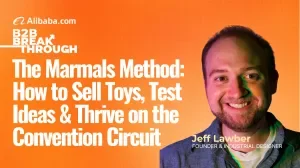What does it take to build a toy business that captures the imagination of both children and adults? For Jeff Lawber, creator of Marmal magnetic toys, the answer lies in something many entrepreneurs overlook: unfiltered, real-time customer feedback.
While most product developers rely on focus groups and market research, Lawber discovered something more powerful at Comic-Con booths and toy shows. “I found two demographics that really gravitate towards this product,” he explains. “I have kids aged probably four to about 14 that use my toy as a construction toy, as an art toy. But then there’s a jump to about 24 and up that use this as a desktop fidget toy.”
This unexpected dual market emerged not from boardroom strategy sessions, but from watching customers interact with his product in real time. Parents would buy Marmal for their children, then return hours later saying, “You know what? This is cool. I need one for my desk.”
Table of Contents
The Power of Prototyping in Public
Navigating Supply Chain Reality
Building Community Through Creativity
The Power of Prototyping in Public
Unlike many entrepreneurs who guard their ideas behind NDAs, Lawber takes a radically different approach. At every trade show, he brings prototypes—often crude 3D-printed models—just to gauge reaction. “That market research has been worth its weight in gold,” he notes. “It doesn’t have to be fancy, it could just be a crude model, but just to see what’s the reaction?”
This willingness to show unfinished work has paid dividends. One customer story particularly stuck with him: a mother who bought three Marmal toys before a family trip to Hawaii returned a year later to share that her children never touched their iPads during the entire vacation, choosing instead to play with the magnetic toys on the plane, in the hotel, and on the beach.
How do you build that kind of customer loyalty? The answer isn’t in perfect polish—it’s in authentic connection and continuous iteration based on real-world use.
Navigating Supply Chain Reality
Behind Marmal’s whimsical exterior lies a complex manufacturing operation. Lawber maintains relationships with over two dozen suppliers, a choice that might seem overwhelming but provides crucial flexibility. “I like to have my fingers in all of that, making sure everything’s going smoothly,” he explains.
This hands-on approach proved essential when tariffs threatened to derail his business. “I had everything negotiated with all the factories. I had all the quotes, everything prepped, ready to go,” Lawber recalls about his new product line launch. When tariffs spiked, he faced a choice: pay double for the same products or find another way.
Instead of panic, Lawber found opportunity. The crisis pushed him toward domestic innovation and 3D printing solutions. “You really started thinking more about innovation and what can be done domestically or what could be done even in your basement on a 3D printer.”
Building Community Through Creativity
What sets Marmal apart isn’t just the product—it’s the community Lawber has fostered around it. Customers regularly tag him in social media posts showing their creations, including impressive stop-motion animation videos made with the toys. “I never really saw this as an outlet for that,” he admits, “but here you are on social media and someone tags you in a video as like, look what I made.”
This organic user-generated content doesn’t just provide free marketing; it drives product development. Customer creations inspire new accessories, characters, and expansion lines. The feedback loop between creator and community has become Marmal’s secret weapon.
For entrepreneurs wondering whether direct customer engagement is worth the investment, Lawber’s five-year journey from pandemic launch to thriving business provides a compelling answer. Sometimes the best market research happens not in conference rooms, but in convention halls where real customers can touch, play with, and react to your product in real time.
Ready to transform your customer feedback process? Start by finding where your customers naturally gather—and bring your prototypes along.
We went all in, see the whole video on YouTube!




